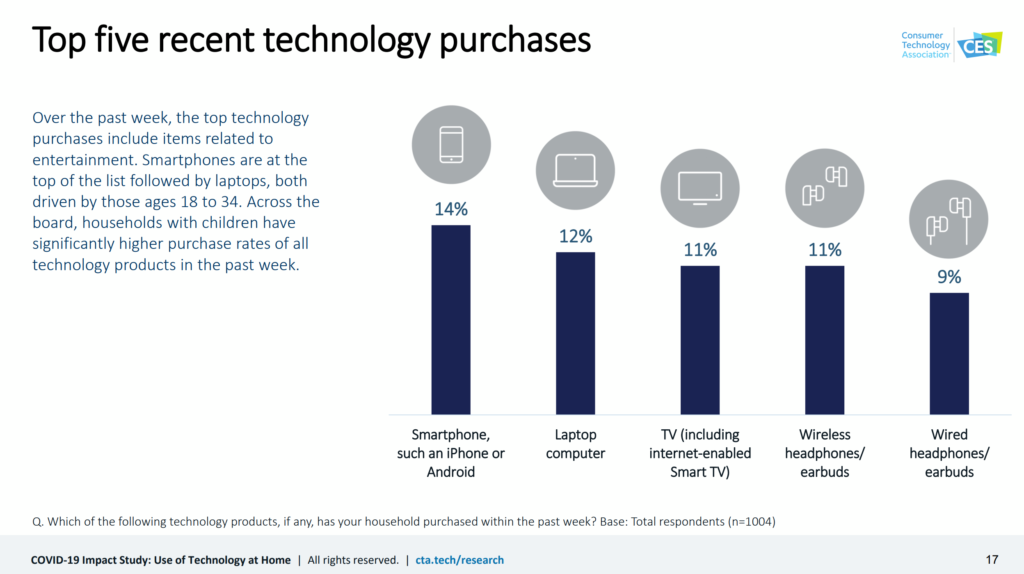 As people conform to the #StayHome lifestyle to #FlattenTheCurve of the coronavirus pandemic, technology is transforming peoples’ home lives for working, playing, and socializing.
As people conform to the #StayHome lifestyle to #FlattenTheCurve of the coronavirus pandemic, technology is transforming peoples’ home lives for working, playing, and socializing.
The Consumer Technology Association has conducted the COVID-19 Impact Study assessing the use of technology at home, exploring U.S. households’ changing behaviors for consuming content, stocking the pantry, engaging with social media, and using online health and fitness tools.
This research surveyed 1,004 U.S. adults 18 and over in March 2020 — early in the U.S. pandemic’s national “curve.”
 U.S. consumers’ top five technology purchases in mid-March 2020 were for smartphones, laptop computers, TVs, and headphones/earbuds.
U.S. consumers’ top five technology purchases in mid-March 2020 were for smartphones, laptop computers, TVs, and headphones/earbuds.
These become the tech-platforms for people working, living, socializing, and accessing health care virtually at home.
It’s useful to consider peoples’ new normal-at-home in terms of Maslow’s hierarchy. Here’s a great illustration of the hierarchy by urban designer/civic specialist Mallory Baches which graphically portrays the hierarchy with symbols for each level of need — at the base, physiological basic needs (food, water, warmth, rest); above that, security and safety; third, the need for socialization and connection (intimate relationships, friends); fourth, approval and recognition; and finally at the apex, the need for self-actualization and personal achievement.
For living in the COVID-19 era, the most basic needs in Maslow’s hierarchy have dealt with grocery shopping and filling the pandemic pantry as Nielsen has coined the phenomenon. Consumers have increase their use of online services for ordering household items, CTA’s poll found.
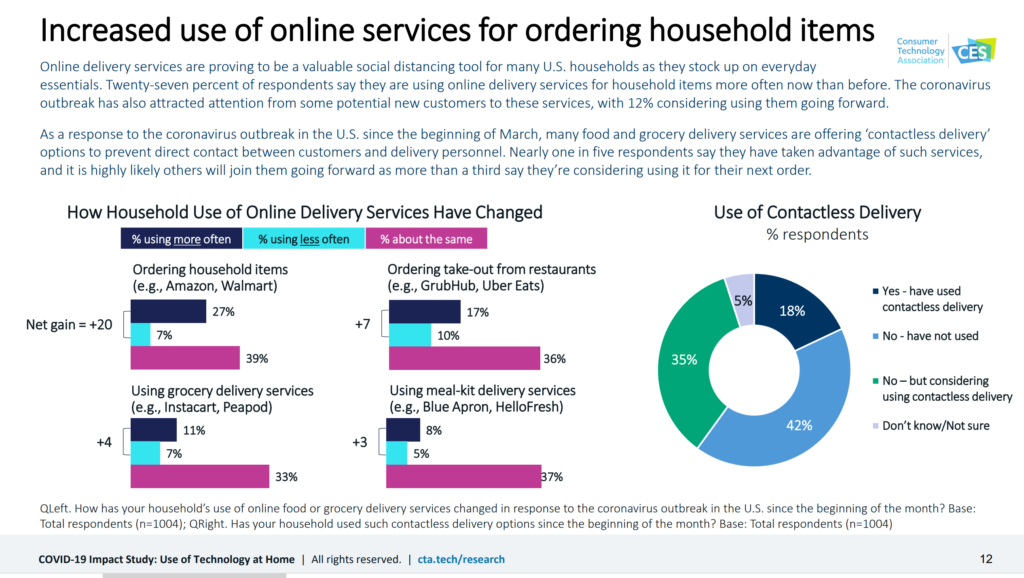 As people practice physical distancing, they’ve amped up their use of ecommerce platforms for shopping for household items, food, and other goods for cocooning at home. Amazon and Walmart as shopping platforms, and grocery delivery channels such as Instacart and Peapod, are working overtime to address the demands of online consumers.
As people practice physical distancing, they’ve amped up their use of ecommerce platforms for shopping for household items, food, and other goods for cocooning at home. Amazon and Walmart as shopping platforms, and grocery delivery channels such as Instacart and Peapod, are working overtime to address the demands of online consumers.
Demand for subscription meal-kits have also grown in this #StayHome life, and many consumers also ordering from take-out services their local restaurants offer to stay in business as essential services in communities that have locked-down retail and other brick-and-mortar services. Nearly one-fourth of U.S. consumers are using online ordering more often, and half of people using it about the same amount.
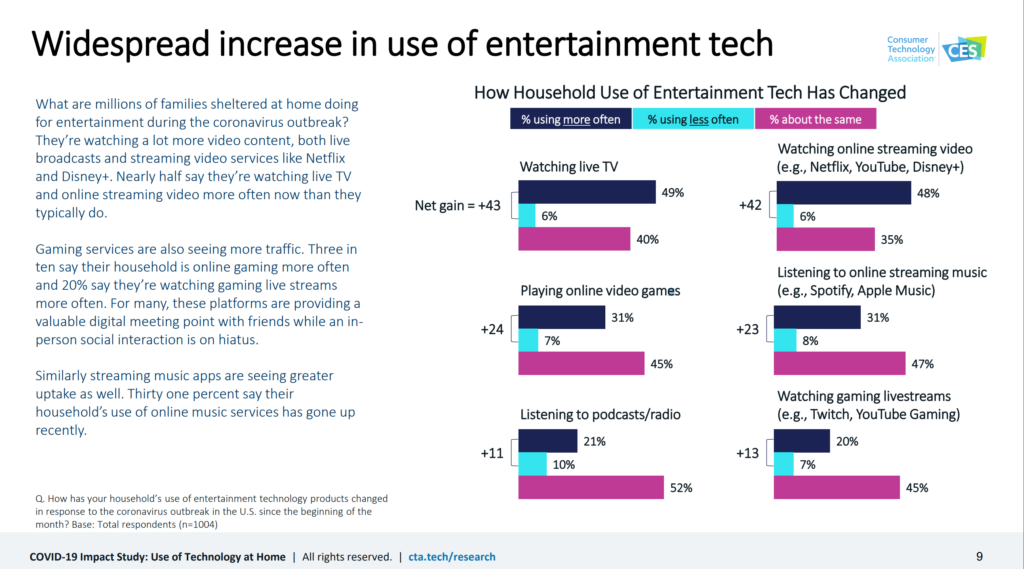 For entertainment, 1 in 2 U.S. consumers are watching live TV more often, 1 in 2 watching online streaming video more often (such as Disney+ and Netflix), and one-third are playing online video games more often as well as listening to online streaming music (like Apple Music or Spotify).
For entertainment, 1 in 2 U.S. consumers are watching live TV more often, 1 in 2 watching online streaming video more often (such as Disney+ and Netflix), and one-third are playing online video games more often as well as listening to online streaming music (like Apple Music or Spotify).
One in four people are using a new streaming video service for the first time, and 14% a new streaming service that offers live TV (e.g., Sling TV, YouTube TV).
Gaming is up: Twitch and YouTube Gaming, for example, are benefiting from rising demand for online gaming, and Xbox Live and PlayStation Plus are gaining new adopters.
 For socializing, the uptake in using social media more often has clearly attracted new users and more intense use by existing users. Grandparents, physically separated from beloved grandchildren, have become “Baby Zoomers” with Boomers adopting Zoom, Skype and Facetime for virtual meet-ups with family members. [At this Easter and Passover spring season, we’ll see virtual meals and Seder get-togethers happening over the tech platforms to be a new-normal for now in helping families convene with loved ones sharing rituals].
For socializing, the uptake in using social media more often has clearly attracted new users and more intense use by existing users. Grandparents, physically separated from beloved grandchildren, have become “Baby Zoomers” with Boomers adopting Zoom, Skype and Facetime for virtual meet-ups with family members. [At this Easter and Passover spring season, we’ll see virtual meals and Seder get-togethers happening over the tech platforms to be a new-normal for now in helping families convene with loved ones sharing rituals].
Social networks facilitate virtual cocktail hours, work groups, and religious communities to come together, bolstering one of Maslow’s key human needs: the need for connections to avert isolation and loneliness, risk factors for mental health, exacerbating dementia, and other physical health conditions.
 For health and fitness, the most-recommended physical activity has been walking outside — being mindful about keeping 6 feet apart through social distancing. But technology is also playing a role inside the home for supporting online health and fitness.
For health and fitness, the most-recommended physical activity has been walking outside — being mindful about keeping 6 feet apart through social distancing. But technology is also playing a role inside the home for supporting online health and fitness.
11% of people are using health and fitness services online more often, and 43% about the same. Affluent households drive this trend, CTA found: 1 in 4 affluent folks are using online health and fitness services more often. [Sidebar: this has been a criticism of a digital health divide based on socioeconomic status for some time].
Other research such as this report from Kaiser Health News identified the quick adoption of telemedicine services in the COVID-19 pandemic. Some consumers experienced several hours’ wait times for telehealth company services in “virtual waiting rooms.”
CTA summarizes that, “the coronavirus outbreak has simply accelerated an existing uptrend [of technology adoption at home]…this could be the catalyst that pulls in millions of new users…for the time being, Americans are relying on these tech solutions to stay safe, but the convenience and value they offer might help them stick around long after the crisis.”
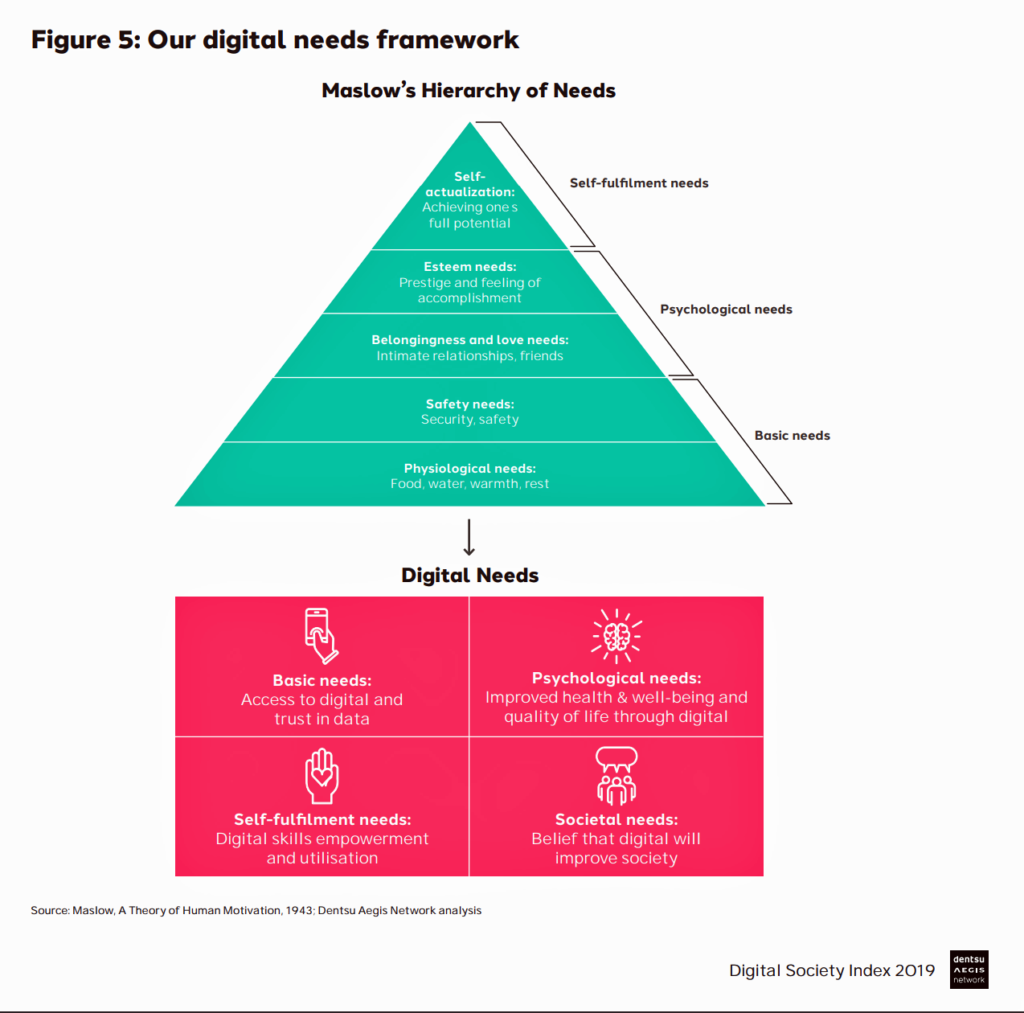 Health Populi’s Hot Points: As people increasingly adopt digital life-styles across their daily life-flows, their personal Maslow Hierarchies morph into digital needs from basic through self-fulfillment needs. Here’s how Dentsu Aegis characterized this updated hierarchy in their study on the 2019 Digital Society Index.
Health Populi’s Hot Points: As people increasingly adopt digital life-styles across their daily life-flows, their personal Maslow Hierarchies morph into digital needs from basic through self-fulfillment needs. Here’s how Dentsu Aegis characterized this updated hierarchy in their study on the 2019 Digital Society Index.
The CTA study revealed a snippet of health consumers’ adoption of online services for health in the COVID-19 era. There are many flows for healthcare and wellness underneath these consumer statistics.
In the physiological and safety needs for COVID-19 consumers, the demand for cleanliness, hygiene, and self-care is bolstered through ecommerce channels. Amazon quickly suppressed sellers who were gouging consumers seeking masks, gloves, Lysol and other products for managing the pandemic at home. The hoarding of toilet tissue became a normal in most markets, with ties to Maslow’s basic needs clearly explained in this TIME essay.
The new basic need underpinning these are broadband and connectivity. Without connection to the N of 1, not just the “last mile,” that health consumer or caregiver with the slick new smartphone can’t access WiFi if it’s not available where they live and/or they can’t afford their data plan. The FCC is working to solve this challenge, which has been a long-overlooked social determinant of health for several years.
Searches on Google and WebMD have grown for topics from understanding the general C19 virus to self-care, the use of acetaminophen vs. ibuprofen, or the Rx for hydrochloroquine which has not yet been approved on-label for the coronavirus, spurring a shortage of the medicine for on-label use for patients with lupus, malaria, and other conditions.
I’m with the CTA’s forecast as the #StayHome ethos permeates our work lives, social lives, and health-lives. This is telehealth’s moment to shine, as my colleagues in the field concur, with the ability to help people — both health consumers and caregivers, and providers — manage the risk of spreading the virus.
For now, in this COVID-19 moment with our local viral curves on the upswing, we’ll continue to physically distance while remaining close socially via virtual networks. Here’s the rationale from our most-trusted public health leaders: Dr. Fauci, Dr. Birx, and Dr. Adams. Stay well and stay home! Let’s #FlattenTheCurve, together.


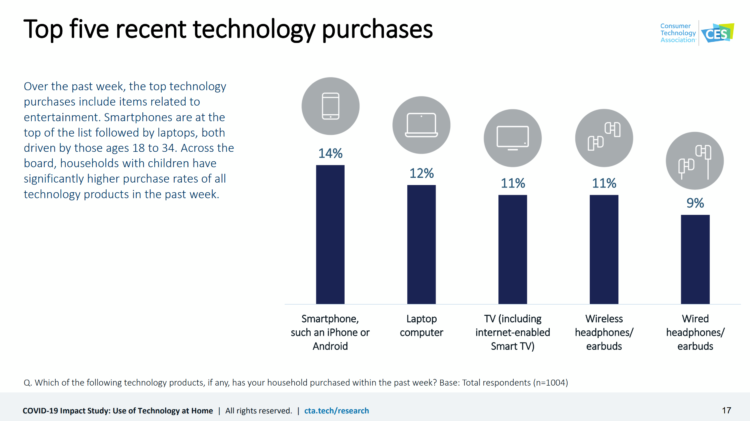


 Thank you, Trey Rawles of @Optum, for including me on
Thank you, Trey Rawles of @Optum, for including me on  I was invited to be a Judge for the upcoming
I was invited to be a Judge for the upcoming  For the past 15 years,
For the past 15 years,